
Nepticulidae is a family of very small moths with a worldwide distribution. They are characterised by eyecaps over the eyes. These pigmy moths or midget moths, as they are commonly known, include the smallest of all living moths, with a wingspan that can be as little as 3 mm in the case of the European pigmy sorrel moth, but more usually 3.5–10 mm. The wings of adult moths are narrow and lanceolate, sometimes with metallic markings, and with the venation very simplified compared to most other moths.
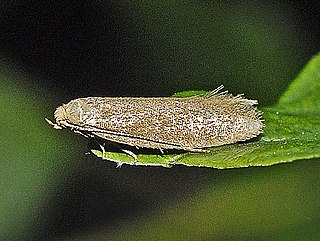
Pseudatemelia subochreella, the straw-coloured tubic, is a species of gelechioid moth.
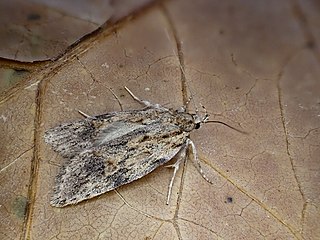
Izatha voluptuosa is a species of moth in the family Oecophoridae. It is endemic to New Zealand. This species is classified as "Not Threatened" by the Department of Conservation.

Izatha copiosella is a moth of the family Oecophoridae. It is endemic to New Zealand, where it is found on the south-eastern parts of the North Island and throughout the South Island except the West Coast. Larvae are found in dead wood and are likely to use kōwhai species as hosts. The adults are night fliers and are attracted to light. They are on the wing in January and February.
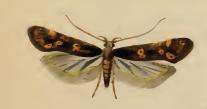
Mirificarma lentiginosella is a moth of the family Gelechiidae. It is found from most of Europe to the Ural Mountains and Turkey.
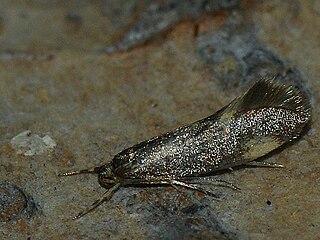
Metalampra cinnamomea is a moth of the family Oecophoridae. It was described by Philipp Christoph Zeller in 1839. It is found in most of Europe, except the Iberian Peninsula, most of the Balkan Peninsula, Ireland and Great Britain.
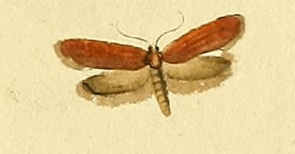
Crassa tinctella, the tinted tubic, is a moth of the family Oecophoridae. It was described by Jacob Hübner in 1796. It is found in most of Europe, except Ireland, the Iberian Peninsula and most of the Balkan Peninsula.
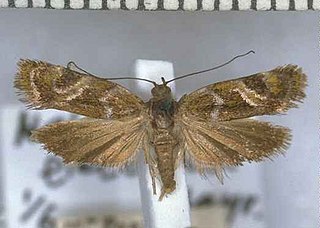
Hierodoris electrica is a moth of the family Oecophoridae. It was described by Edward Meyrick in 1889. It is endemic to New Zealand, where it has been reported from the northern and southern parts of the South Island. The larva of H. electrica has yet to be described. The wingspan is between 15 and 16.5 mm. The ground colour of the forewings is dark brown, with narrow yellow scales overlaying this base colour. The hindwings are brown. The known larval host species is Olearia nummulariifolia.

Eratophyes is a genus of moths in the family Oecophoridae. It contains only one species, Eratophyes amasiella, which is found in Asia Minor, the Netherlands, Germany, Denmark and Sweden. It was first recorded in Belgium in 2004. The species was probably accidentally introduced in western Europe, most likely as a caterpillar or pupa, with logs.
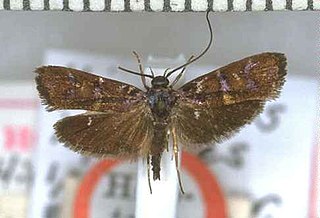
Hierodoris iophanes is a moth of the family Oecophoridae. It was described by Edward Meyrick in 1912. This species can be distinguished from others in its genus by the purple metallic colouration as well as the blue-white mark on its forewings. It is endemic to New Zealand, where it has been recorded from Auckland to Southland. This species inhabits native forest or scrub, with the adults preferring open glades. They are known to be on the wing from November until February and fly during daylight hours, being active on hot sunny days. Larvae feed on the interior of twigs of Prumnopitys ferruginea. The twigs had evidence of oviposition scars of cicadas and the larvae were collected in October after reddish-brown frass indicated their location within the twigs.
Afdera jimenae is a moth in the family Oecophoridae. It was described by Ogden and Parra in 2001. It is found in Chile, where it has been recorded from the Península de Hualpén.

Asaphodes abrogata is a moth in the family Geometridae. It is endemic to New Zealand and can be found from the central North Island as well as the South Island. This species is inhabits open country at altitudes of between 2000 and 4000 ft. Larvae have been reared on Plantago species including Plantago coronopus. It has been recommended that Plantago raoulii be planted to attracted this species. Adults are on the wing in February and March.

Hierodoris stella is a species of moth in the family Oecophoridae. This species is endemic to New Zealand and occurs in Auckland, Taranaki, Hawkes Bay, Bay of Plenty and Wellington. As at 2005 the larvae of this species is unknown as is its host plant. The adult moth frequents forest and are on the wing in January and February. It is classified as "At Risk, Relict'" by the Department of Conservation.

Tingena loxotis is a species of moth in the family Oecophoridae. This species is endemic to New Zealand and is found in the North Island. This species is found in gardens and are known to enter houses. Adults are on the wing in December and January. It is classified as "Data Deficient" by the Department of Conservation.
Gymnobathra rufopunctella is a species of moth in the family Oecophoridae. This species is in need of taxonomic revision and probably belongs to a separate genus. It is endemic to New Zealand. It has been classified as Data Deficient by the Department of Conservation.
Decantha is a genus of moths belonging to the family Oecophoridae.

Tingena monodonta is a species of moth in the family Oecophoridae. It is endemic to New Zealand and has been found in both the North and South Islands. This species inhabits native beech forest at altitudes of between 2500 - 3000 ft. The adults of the species are on the wing from November and December.

Tingena pronephela is a species of moth in the family Oecophoridae. It is endemic to New Zealand and is found in the southern parts of the South Island. The species inhabits the outskirts of scrub and native forest. The adults of this species are on the wing from October to February.
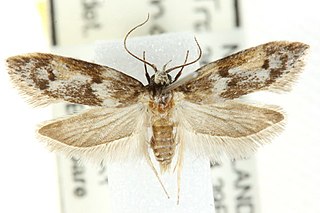
Trachypepla importuna is a moth of the family Oecophoridae first described by Edward Meyrick in 1927. This moth is regarded as having been introduced to New Zealand and is presumed to be native to Australia. T. importuna has been collected in both the North and South Islands of New Zealand. It inhabits native scrub and adults are on the wing in January and February. The placement of this species in the genus Trachypepla is regarded as being unsatisfactory and in need of revision.

Trachypepla ingenua is a moth of the family Oecophoridae first described by Edward Meyrick in 1911. It is endemic to New Zealand and has been collected in both the North and South Islands. This species is one of the larger in the genus Trachypepla and the colouration of the adults imitates bird droppings. The preferred habitat of T. ingenua is native forest and adults are on the wing from December to February.
















